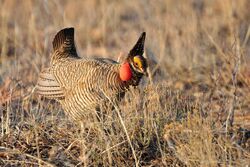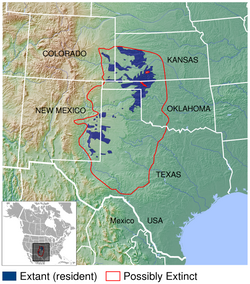Biology:Lesser prairie chicken
| Lesser prairie chicken | |
|---|---|

| |
| A lesser prairie chicken in New Mexico | |
| Scientific classification | |
| Domain: | Eukaryota |
| Kingdom: | Animalia |
| Phylum: | Chordata |
| Class: | Aves |
| Order: | Galliformes |
| Family: | Phasianidae |
| Genus: | Tympanuchus |
| Species: | T. pallidicinctus
|
| Binomial name | |
| Tympanuchus pallidicinctus (Ridgway, 1873)
| |

| |
| Lesser prairie chicken range.[2][3] | |
| Synonyms | |
|
Tympanuchus cupido pallidicinctus | |
The lesser prairie chicken (Tympanuchus pallidicinctus) is a species in the grouse family.
Description
It is a medium to large bird, striped white and brown, slightly smaller and paler than its near relative the greater prairie chicken (T. cupido). Adults range from 15.0 to 16.1 inches (38 to 41 cm) in length and 22.1 to 28.7 ounces (630 to 810 g) in weight.[4]
Distribution
About half of its current population lives in western Kansas , with the other half in the sandhills and prairies of western Oklahoma, the Texas Panhandle including the Llano Estacado, eastern New Mexico, and southeastern Colorado.
Behavior
Like its larger relative, it is known for its lekking behavior.
Conservation
Considered "vulnerable" by the IUCN due to its restricted and patchy range, it is vulnerable to habitat destruction.[1] The lesser prairie chicken's habitat has been reduced by 85%, and their population has declined by as much as 99% in some ecoregions as a result. Of the remaining patches of suitable habitat, only around 0.1% are sufficiently contiguous to sustain even a minimum population of the birds.[citation needed] There is evidence suggesting that global warming may have a particularly detrimental influence by greatly reducing the size of the sagebrush ecosystem.[5] Subfossil remains are known, e.g., from Rocky Arroyo in the Guadalupe Mountains, outside the species' current range but where more habitat existed in the less humid conditions in the outgoing last ice age. Range contraction apparently took place no later than about 8000 BC.[citation needed]
Threatened and endangered species listings
On March 27, 2014, the lesser prairie chicken was listed as threatened under the Endangered Species Act but the listing was vacated in 2015 following a legal challenge.[6] On June 1, 2021, the US Fish and Wildlife Service (USFWS) proposed splitting the species into two segments. The northern one, covering Oklahoma, Colorado, Kansas, and a portion of Texas, would be listed as threatened, and the southern one, covering New Mexico and a portion of Texas, as endangered.[7] On November 17, 2022, the USFWS published a final rule listing the Southern Distinct Population Segment (DPS) of the lesser prairie-chicken as endangered and the Northern DPS as threatened.[8][9] Implementation of the rule was delayed, and it took effect on March 27, 2023.[10]
In 2015, Senator Jerry Moran (R-Kan) introduced an amendment to legislation authorizing construction of the Keystone XL Pipeline that would overturn the listing. He disputed the listing as, "... another example of unnecessary intrusion into private lives and businesses by the federal government." His action was supported by the American Energy Alliance and opposed by the League of Conservation Voters.[11]
When the Senate voted on the Keystone bill, it did not get the 60 votes in favor that was required to pass. It got only 53 Republican and one Democratic Senator to vote in favor.[11]
The United States Department of the Interior proposed creating a Lesser Prairie Chicken Preserve as a national monument, but action was never taken action on the proposal.[12]
In May 2023, the U.S. Senate voted to strip the lesser prairie chicken of its new listing using its authority under the Congressional Review Act. President Joe Biden's administration threatened to veto the bill if the House of Representatives passed it,[13] which the House did on July 27.[14][15] The bill was passed by the Senate, but vetoed by Biden on September 27, 2023.[16]
References
- ↑ 1.0 1.1 BirdLife International (2018). "Tympanuchus pallidicinctus". IUCN Red List of Threatened Species 2018: e.T22679519A131795740. doi:10.2305/IUCN.UK.2018-2.RLTS.T22679519A131795740.en. https://www.iucnredlist.org/species/22679519/131795740. Retrieved 12 November 2021.
- ↑ BirdLife International and NatureServe (2014) Bird Species Distribution Maps of the World. 2012. Tympanuchus pallidicinctus. In: IUCN 2015. The IUCN Red List of Threatened Species. Version 2015.2. http://www.iucnredlist.org . Downloaded on 09 July 2015.
- ↑ National Geophysical Data Center, 1999. Global Land One-kilometer Base Elevation (GLOBE) v.1. Hastings, D. and P.K. Dunbar. National Geophysical Data Center, NOAA. doi:10.7289/V52R3PMS [access date: 2015-03-16]
- ↑ Cornell Lab of Ornithology. "Lesser Prairie-Chicken Identification". Cornell University. https://www.allaboutbirds.org/guide/Lesser_Prairie-Chicken/id.
- ↑ Youth, Howard (2007). "Lekkin' Grouse on the Prairie". Zoogoer March/April 2007. National Zoo. http://nationalzoo.si.edu/Publications/ZooGoer/2007/2/Lekking.cfm.
- ↑ "U.S. lists lesser prairie chicken as threatened, energy groups wary". Reuters. http://feeds.reuters.com/~r/reuters/environment/~3/ULdnsx1tKwk/story01.htm.[|permanent dead link|dead link}}]
- ↑ USFWS (June 1, 2021). "Endangered and Threatened Wildlife and Plants; Lesser Prairie-Chicken; Threatened Status With Section 4(d) Rule for the Northern Distinct Population Segment and Endangered Status for the Southern Distinct Population Segment". Federal Register 86 (103): 29432–29482. https://www.govinfo.gov/content/pkg/FR-2021-06-01/pdf/2021-11442.pdf#page=1. Retrieved 4 March 2022.
- ↑ USFWS (17 November 2022). "Endangered and Threatened Wildlife and Plants; Lesser Prairie-Chicken; Threatened Status With Section 4(d)Rule for the Northern Distinct Population Segment and Endangered Status for the Southern Distinct Population Segment". Federal Register 87 (226): 72674–72755. 87 FR 72674
- ↑ 87 FR 73971
- ↑ 88 FR 4087
- ↑ 11.0 11.1 Sheppard, Kate. "Keystone, Meet The Grouse Wars". Huffington Post. January 28, 2015. November 19, 2015.
- ↑ Kirk Johnson (February 20, 2010). "In the West, 'Monument' is a Fighting Word". New York Times: p. A8. https://www.nytimes.com/2010/02/20/us/politics/20utah.html.
- ↑ "STATEMENT OF ADMINISTRATION POLICY". Executive Office of the President, Office of Management and Budget. 3 May 2023. https://www.whitehouse.gov/wp-content/uploads/2023/05/SJRes-9-SAP.pdf.
- ↑ National Audubon Society (27 July 2023). "House Vote to End Lesser-Prairie Chicken Protections Ignores Clear Science". https://www.audubon.org/news/house-vote-end-lesser-prairie-chicken-protections-ignores-clear-science.
- ↑ "Congress passes GOP measures to undo protections for endangered lesser prairie chicken, northern bat". 27 July 2023. https://www.cpr.org/2023/07/30/congress-passes-gop-measures-undo-protections-endangered-lesser-prairie-chicken-northern-bat/.
- ↑ "Biden vetoes two Republican-led bills to undo protections for prairie chicken and northern bat" (in en). 2023-09-27. https://apnews.com/article/prairie-chicken-longeared-bat-endangered-species-f217ab4fb07951bc5613c1c7e486809a.
External links
- BirdLife Species Factsheet
- Audubon Watchlist - Lesser Prairie Chicken
- Lesser Prairie-Chicken videos on the Internet Bird Collection
Wikidata ☰ Q19551 entry
 |


